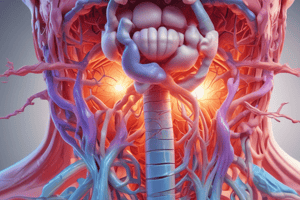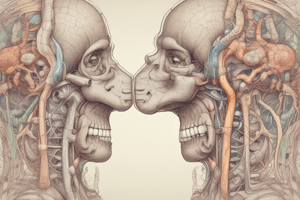Podcast
Questions and Answers
What is the primary function of the alveoli in the lungs?
What is the primary function of the alveoli in the lungs?
- To facilitate the exchange of respiratory gases (correct)
- To filter air as it enters the lungs
- To produce mucus for the respiratory tract
- To provide structural support for the lungs
What is the average diameter of an individual alveolus in the human lung?
What is the average diameter of an individual alveolus in the human lung?
- 0.1 mm
- 0.2 mm (correct)
- 0.05 mm
- 0.5 mm
What is the thickness of the walls of the alveoli?
What is the thickness of the walls of the alveoli?
- 0.01 mm
- 0.1 mm
- 0.001 mm (correct)
- 0.0001 mm
What is the approximate number of alveoli in the human lungs?
What is the approximate number of alveoli in the human lungs?
Where does the exchange of respiratory gases (oxygen and carbon dioxide) occur?
Where does the exchange of respiratory gases (oxygen and carbon dioxide) occur?
What is the role of the capillaries in the respiratory system?
What is the role of the capillaries in the respiratory system?
What happens to the deoxygenated blood as it passes through the capillary beds around the alveoli?
What happens to the deoxygenated blood as it passes through the capillary beds around the alveoli?
What happens to the carbon dioxide in the deoxygenated blood as it passes through the capillary beds around the alveoli?
What happens to the carbon dioxide in the deoxygenated blood as it passes through the capillary beds around the alveoli?
What is the purpose of the extensive network of bronchioles in the lungs?
What is the purpose of the extensive network of bronchioles in the lungs?
What is the main purpose of the dense network of capillaries surrounding the alveoli?
What is the main purpose of the dense network of capillaries surrounding the alveoli?
Flashcards
Alveoli
Alveoli
Tiny air sacs in the lungs where gas exchange takes place.
Gas Exchange in Alveoli
Gas Exchange in Alveoli
The primary function of the alveoli is to facilitate the exchange of oxygen and carbon dioxide between the air in the lungs and the blood.
Alveoli Size
Alveoli Size
The average diameter of an alveolus in the human lung is approximately 0.2 mm.
Alveoli Wall Thickness
Alveoli Wall Thickness
Signup and view all the flashcards
Number of Alveoli
Number of Alveoli
Signup and view all the flashcards
Capillaries and Alveoli
Capillaries and Alveoli
Signup and view all the flashcards
Blood Oxygenation
Blood Oxygenation
Signup and view all the flashcards
Bronchiole Function
Bronchiole Function
Signup and view all the flashcards
Efficient Gas Exchange
Efficient Gas Exchange
Signup and view all the flashcards
Capillary Role in Gas Exchange
Capillary Role in Gas Exchange
Signup and view all the flashcards
Study Notes
Diffusion in Humans
- In the lungs, oxygen and carbon dioxide molecules diffuse down their own concentration gradients between the moisture on the inner lining of the alveoli and the blood.
- This diffusion occurs down a concentration gradient.
Air Sacs and Alveoli
- Alveoli are perfectly adapted for the process of diffusion, having thin and moist walls that help oxygen and carbon dioxide to diffuse.
- A single alveolus has a thin wall, one cell thick, and is surrounded by a dense network of capillaries.
- The capillaries also have very thin walls, which helps the diffusion of oxygen and carbon dioxide into and from the blood.
How the Alveoli and Capillaries Work
- Air containing oxygen enters the lungs and passes into each alveolus from outside.
- Deoxygenated blood containing carbon dioxide comes from the rest of the body.
- Oxygen diffuses into the blood from the alveoli, while carbon dioxide diffuses from the blood into the alveoli.
- The blood becomes oxygenated, and oxygenated blood leaves the lungs and returns to the heart.
Inhaled and Exhaled Air
- Inhaled air into the lungs: 20.95% oxygen, 79% nitrogen, 0.04% carbon dioxide, and 0.01% water vapor.
- Exhaled air out of the lungs: 16% oxygen, 79% nitrogen, 4.0% carbon dioxide, and 1% water vapor.
Breathing
- Breathing is the process of moving air in and out of the lungs.
- Breathing is achieved by making the chest cavity larger or smaller, which results in a change in pressure within the lungs.
- This change in pressure forces air either in (inhale) or out (exhale) of the lungs, known as ventilation of the lungs.
- Inspiration (breathing in) involves the contraction of rib muscles and diaphragm muscle, which increases the volume of the chest cavity.
Studying That Suits You
Use AI to generate personalized quizzes and flashcards to suit your learning preferences.



